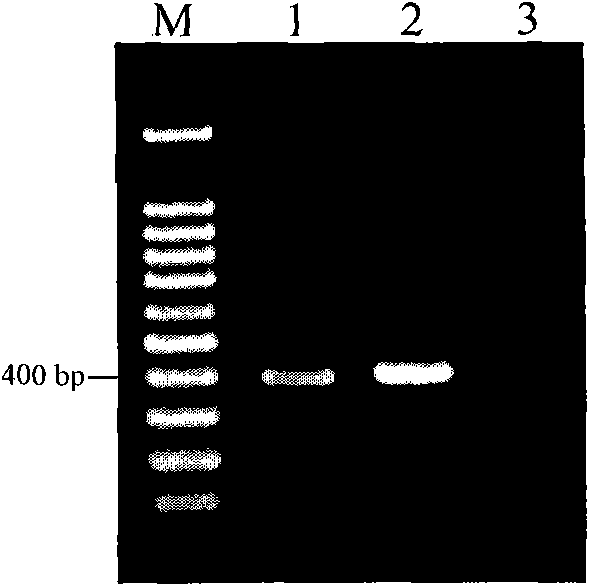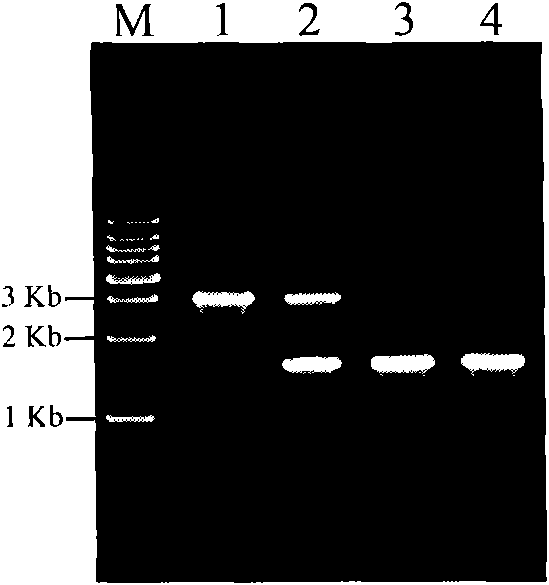A kind of β-ketothiolase related to the 3-hv monomer synthesis of phbv, its coding gene and application
A technology for encoding genes and amino acids, applied in the field of beta-ketothiolase
- Summary
- Abstract
- Description
- Claims
- Application Information
AI Technical Summary
Problems solved by technology
Method used
Image
Examples
Embodiment 1
[0037] Example 1. Obtaining of β-ketothiolase and its coding gene
[0038] The bacterial strain was isolated from the bottom mud of the salt pond in Tianjin sea salt field, and the culture medium used for the separation was AS-168 medium (containing: 5.0g casamino acids per liter, 5.0g yeast extract, 1.0 g sodium glutamate (sodium glutamate), 3.0g sodium citrate, 200g NaCl, 20g MgSO 4 ·7H 2 O, 2.0g KCl, 0.36g FeSO 4 4H 2 O and 0.36 mg MnCl 2 4H 2 O, pH 7.2). An extreme halophilic archaeal strain XH1001 was isolated. The strain can form reddish colonies when grown on AS-168 agarose plate (AS-168+1.2% agarose). Colonies are opaque with smooth edges. The bacterium is Gram-negative, and the cells are usually 1 to 2 μm wide and 2 to 3 μm long by electron microscopy. Physical and chemical experiments found that the optimum growth NaCl concentration of XH1001 is 20% to 25%, and it can still grow at 10% NaCl concentration; the growth pH range is 5.2 to 8.0; it is aerobic; it ...
Embodiment 2
[0041] Example 2, functional identification of phaA1
[0042] 1. Transcription of gene phaA1 in fermentation medium
[0043] 1. Extraction of total RNA from Haloferax sp.XH1001 CGMCC No.3822 in the fermentation medium
[0044] 1) Put Haloferax sp.XH1001 CGMCC No.3822 in AS-168 medium (each liter contains: 5.0g acid hydrolyzed casein (casamino acids), 5.0g yeast extract (yeast extract), 1.0g sodium glutamate ( sodiumglutamate), 3.0g sodium citrate, 200g NaCl, 20g MgSO 4 ·7H 2 O, 2.0g KCl, 0.36g FeSO 4 4H 2 O and 0.36 mg MnCl 2 4H 2 O, the rest is water, pH 7.2) and cultivated at 37°C for 3-4 days to make it enter the logarithmic growth phase.
[0045] 2) According to the inoculation amount of 5%, inoculate (Haloferax sp.) XH1001 CGMCC No.3822 in MG (containing: 200g NaCl, 20g MgSO 4 ·7H 2 O, 2.0g KCl, 1g sodium glutamate, 37.5mg KH 2 PO 4 , 50mg FeSO 4 ·7H 2 O, 0.36 mg MnCl 2 4H 2 O, 1g of yeast extract (yeastextract), 20g of glucose (glucose, pH 7.2) in the cult...
Embodiment 3
[0101] Embodiment 3, phaA1 gene application
[0102] The recombinant plasmid pWL102-A constructed in Step 2 of Example 2 was transformed into the wild-type strain Haloarcula hispanica CGMCC No.1.2049 (purchased from CGMCC, The strain number is CGMCC No.1.2049), and the obtained recombinant strain is named Haloarcula hispanica / pWL 102-A.
[0103] Fermentation and analysis were carried out according to the method described in Example 2. Using the same method, the recombinant bacteria obtained by introducing the empty vector pWL102 into Haloarcula hispanica CGMCC No.1.2049 (named Haloarcula hispanica / pWL102) were fermented and analyzed as a control. The wild-type strain Haloarculahispanica CGMCC No.1.2049 without any treatment was also used as a control.
[0104] The experiment was repeated 3 times, and the results were averaged. Experimental results such as Figure 5 A is the result of polyhydroxybutyrate copolyester produced by Haloarculahispanica / pWL102 (or the result of p...
PUM
 Login to View More
Login to View More Abstract
Description
Claims
Application Information
 Login to View More
Login to View More - R&D
- Intellectual Property
- Life Sciences
- Materials
- Tech Scout
- Unparalleled Data Quality
- Higher Quality Content
- 60% Fewer Hallucinations
Browse by: Latest US Patents, China's latest patents, Technical Efficacy Thesaurus, Application Domain, Technology Topic, Popular Technical Reports.
© 2025 PatSnap. All rights reserved.Legal|Privacy policy|Modern Slavery Act Transparency Statement|Sitemap|About US| Contact US: help@patsnap.com



